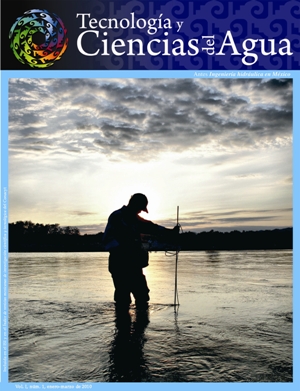Comparative study of domestic wastewater treatments using common duckweed (Lemna minor) and water hyacinth (Eichhornia crassipes) in artificial wetlands.
DOI:
https://doi.org/10.24850/j-tyca-2010-01-05Keywords:
wetland, BOD5, wastewater, Eichhornia, LemnaAbstract
This comparative study of domestic wastewater treatment using natural systems like artificial wetlands shows organic matter (BOD5) removal rates between 70% and 86% using water hyacinth and of 58% using common duckweed. The artificial wetland system behaves hydraulically as a piston-flow model regardless of the aquatic plant used. During the experiment, it was observed that common duckweed contributes characteristic elements to water that increase the effluent's pH (> 11), whereas water hyacinth elevates the pH value in the range of 6-8, thus favoring the stabilization of the organic matter within the biological system.References
ANDERSSON, J.L. et al. Free water surface wetlands for wastewater treatment in Sweden: nitrogen and phosphorus removal. Water Science and Technology. Vol. 27, 2007, pp. 35-39.
APHA. Standard methods for the examination of waste and wastewater. Washington, D.C.: American Public Health Association, 1998.
AVSAR, Y. et al. Rehabilitation by constructed wetland of available wastewater treatment plant in sakhin. Ecological Engineering. Vol. 29, 2007, pp. 27-32.
BRIX, H. Constructed wetland for municipal wastewaster treatment in Europe. Global wetlands: old world and new. Misch, W.J. (editor). Elsevier Science. 1994, pp. 3-5.
EPA. Constructed wetlands treatment of municipal. Wastewater technology fact sheet. September 1999, pp. 1-166.
EPA. Folleto informativo de tecnología de aguas residuales: Humedales de flujo libre superficial. Wastewater technology fact sheet. September 2000a, pp. 1-15.
EPA. Folleto informativo de tecnología de aguas residuales: humedales de flujo subsuperficial. Wastewater technology fact sheet. September 2000b, pp. 1-13.
EPA. Wetlands subsurface flow. Wastewater technology fact sheet. September 2000c, pp. 1-9.
GARAVITO, L., GÓMEZ, E., LÓPEZ, F. Diseño, construcción, puesta en marcha y operación de un sistema de tratamiento de aguas residuales domésticas, mediante humedales artificiales. Trabajo de grado. Bogotá: Universidad Manuela Beltrán, 2008.
JIN-CHENG, L. et al. The selection of the best HRT in compoun constructed wetland on the agricultural wastewater treatment. Journal of Environmental Science and Engineering. Vol. 2, 2008, pp. 24-27.
HADADA, H.R. et al. Macrophyte growth in a pilot scale constructued wetland for industrial wastewater treatment. Chemosphere. Vol. 63, 2006, pp. 1744-1753.
LLAGAS, W. et al. Diseño de humedales artificiales para el tratamiento de aguas residuales en la UNMSM. Revista del Instituto de Investigaciones FIGMMG. Vol. 15, 2006, pp. 85-96.
MAINEA, M.A et al. Renoval efficiency of a constructed wetland for wastewater treatment according to vegetation dominance. Chemosphere. Vol. 68, 2007, pp. 1105-1113.
REED, S. and BROWN, D. Constructed wetland desing. The second generation. Conferencia WPCF, 1991, pp. 1-10.
RODRÍGUEZ-PÉREZ-DE-AGREDA, C. Humedales construidos, estado del arte (I). Ingeniería Hidráulica y Ambiental. Vol. XXIV, núm. 3, 2003a, pp. 35-41.
RODRÍGUEZ-PÉREZ-DE-AGREDA, C. Humedales construidos, estado del arte (II). Ingeniería Hidráulica y Ambiental. Vol. XXIV, núm 3, 2003b, pp. 42-48.
Downloads
Published
How to Cite
Issue
Section
License
Copyright (c) 2010 Tecnología y ciencias del agua

This work is licensed under a Creative Commons Attribution-NonCommercial-ShareAlike 4.0 International License.
By Instituto Mexicano de Tecnología del Agua is distributed under a Creative Commons Attribution-NonCommercial-ShareAlike 4.0 International License. Based on a work at https://www.revistatyca.org.mx/. Permissions beyond what is covered by this license can be found in Editorial Policy.









